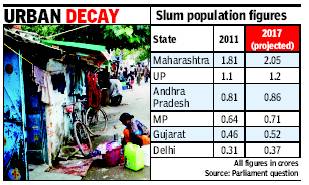Slums: India
This is a collection of articles archived for the excellence of their content. Readers will be able to edit existing articles and post new articles directly |
The extent of the problem
In 2009
Nearly 49,000 slums in India
24% Of Shanties Along Drains, 12% Beside Rly Tracks: NSSO
Mahendra Kumar Singh
New Delhi: Even as the Indian economy remains one of the bright spots in the world showing an upward growth trajectory, around 49,000 slums continue to blight the urban landscape forcing lakhs of people to live in pathetic conditions.
To make things worse, of these 49,000 slums, 24% was located along nallahs and drains and around 12% along railway tracks, according to a report released by National Sample Survey Office (NSSO). Not surprisingly, around 57% of slums came up on public land, owned mostly by local bodies and state government. Though sanitary conditions in the slums in terms of toilet facility during 2008-09 showed an improvement since 2002, a lot still needed to be done.
Toilets with septic tanks (or similar facility) were available in 68% notified and 47% nonnotified slums (up from 66% and 35% respectively in 2002).
At a time when the UPA government has made the ambitious promise of slum-free India, around 10% notified and 20% non-notified slums (though down from 17% and 51% in 2002) did not have any toilet facility at all. The NSSO report also said that around 10% notified and 23% non-notified slums did not have any drainage facility as against 15% for notified and 44% for non-notified slums in 2002.
About 48% of slums were usually affected by waterlogging during monsoon — 32% saw waterlogging inside the slum as well as on the approach road, 7% saw water in the slum but not on the approach road and 9% saw only the approach road waterlogged. Over the last five years, facilities had improved in about 50% of notified slums in terms of roads (both within-slum road and approach road) and water supply. However, the report said about 78% of notified slums and 57% of non-notified slums had a pucca road inside the slum and around 73% notified and 58% non-notified slums had a motorable approach road.
The NSSO report titled ‘Some Characteristics of Urban Slums, 2008-09', found that in 64% of notified slums, a majority of dwellings were pucca, the corresponding percentage for non-notified ones being 50%. Only 1% notified and 7% non-notified slums did not have electricity connection.
In 2013
Slum-free India? No chance
By 2017, Population Will Rise To 104m, Maha Will Top Chart
Dipak Kumar Dash | TNN
The Times of India 2013/08/21
New Delhi: India’s slum population will surge to 104 million by 2017 — or around 9% of the total projected national population of 1.28 billion that year.
This means urban planners will face escalating challenges as these slums will mostly proliferate in sleepy towns and in semi-rural areas, a consequence of an accelerating rural to urban shift across the nation.
According to data provided in Parliament, Maharashtra, Uttar Pradesh, Andhra Pradesh and Madhya Pradesh will host the largest chunks of India’s slum population (see box).
In a reply to a starred question by Nashik MP Sameer Bhujbal last week in Parliament, the government offered a projection of the slum population on the basis of the Pranab Sen Committee report submitted in 2010. The committee’s previous projection of slum population in 2011 was 93 million, or 7% of a total population of 1.21 billion.
But the census of 2011 recorded 1.3 crore urban slum households. So, if a household is estimated at five members, the urban slum population would be around 65 million. This 65 million figure is considerably lower than the Sen Committee’s projection of 93 million slum dwellers in 2011 (based on the 2001 census).
The 2011 census shows the problem is growing as it indicates the percentage of people living in slums in smaller cities with a population of less than a million is rising. While 62% people in these cities are slum dwellers, it is 38% in all million-plus cities that include mega metros like Delhi and Mumbai.
In absolute numbers while million-plus cities have 52 lakh slum households, the count is 85 lakh in the sub-million cities. “We are creating a bigger problem by failing to manage both bigger and smaller cities. Places like Khurja and Bulandshahr close to Delhi have become slums due to faulty planning and poor programme implementation. We can’t allow unchecked and unplanned urban growth. Governments must understand this and take steps keeping aside their political reasons,” said H R Suri, former head of Institute of Town Planners India.
Census data also shows how a large section of the urban population lives in slums in the four metropolitan cities — as high as 41.3% in Greater Mumbai, 29.6% in Kolkata, 28% in Chennai and about 15% in Delhi.
The socio-economic implications of a large slum population — which includes the cost of civic services, housing and health care, and increased crime and social tensions — saw the UPA government frame the Rajiv Awas Yojna as a policy response. The scheme is intended to provide affordable housing to the poor and make urban areas slum free but so far these efforts have registered little progress in focus cities, including Delhi.
